Inventory of Landslides in the Northern Half of the Taihang Mountain Range, China
Abstract
:1. Introduction
2. Study Area
3. Data and Methods
3.1. Data Description
3.2. Interpretation Methods
- Morphological signs: The distribution of the landslide body shows an irregular step-like shape, and there are fissures in its interior, which are mainly located in the center and the leading edge; these fissures are important signs of landslide activity. The undulating terrain formed by the sediments at the leading edge of the landslide presents a tongue-like shape. In addition, the gullies formed by the development of the two sides of the landslide body show the phenomenon of homologous double gullies. It is noteworthy that the perimeter of the landslide presents a rim-chair-like structure, and this morphological change is also an important sign of landslide activity.
- Rock and soil structure signs: The rock and soil within the limits of the landslide often show signs of loosening, as well as discontinuities in the bedrock stratigraphy and production characteristics and surroundings.
- Color signs: Uneven color distribution occurs due to the destruction of vegetation and fragmentation of the surface of the landslide. Sometimes the whole landslide will have a light tone such as greyish white or greenish white.
- Vegetation signs: The vegetation texture is discontinuous, and the vegetation on the landslide body shows a pattern of sabre trees and drunken forest stands.
- Hydrological signs: Unusual bends in rivers or sudden narrowing of local channels. In addition, geological phenomena such as wetlands and springs are present on the landslide surface as well as linear outcrops of groundwater at the leading edge of the slide zone.
4. Results
4.1. Inventory of Landslides in the Northern Half of the Taihang Mountain Range
4.2. Demonstration of Typical Landslides
5. Discussion
5.1. Comparison with the Existing Database of Landslides in the Taihang Mountains Region
5.2. Strengths and Limitations of the Research Methodology
5.3. Future Prospects
6. Conclusions
Author Contributions
Funding
Data Availability Statement
Acknowledgments
Conflicts of Interest
References
- Tiranti, D.; Cremonini, R. Editorial: Landslide hazard in a changing environment. Front. Earth Sci. 2019, 7, 3. [Google Scholar] [CrossRef]
- Xu, C.; Gorum, T.; Tanyas, H. Editorial: Application of remote sensing and GIS in earthquake-triggered landslides. Front. Earth Sci. 2022, 10, 964753. [Google Scholar] [CrossRef]
- Herrera, G.; Mateos, R.M.; García-Davalillo, J.C.; Grandjean, G.; Poyiadji, E.; Maftei, R.; Filipciuc, T.-C.; Jemec Auflič, M.; Jež, J.; Podolszki, L.; et al. Landslide databases in the geological surveys of europe. Landslides 2018, 15, 359–379. [Google Scholar] [CrossRef]
- Gatto, A.; Clò, S.; Martellozzo, F.; Segoni, S. Tracking a Decade of Hydrogeological Emergencies in Italian Municipalities. Data 2023, 8, 151. [Google Scholar] [CrossRef]
- Damm, B.; Klose, M. The landslide database for Germany: Closing the gap at national level. Geomorphology 2015, 249, 82–93. [Google Scholar] [CrossRef]
- Cui, Y.; Yang, W.; Xu, C.; Wu, S. Distribution of ancient landslides and landslide hazard assessment in the Western Himalayan Syntaxis area. Front. Earth Sci. 2023, 11, 1135018. [Google Scholar] [CrossRef]
- Mirus, B.B.; Jones, E.S.; Baum, R.L.; Godt, J.W.; Slaughter, S.; Crawford, M.M.; Lancaster, J.; Stanley, T.; Kirschbaum, D.B.; Burns, W.J.; et al. Landslides across the USA: Occurrence, susceptibility, and data limitations. Landslides 2020, 17, 2271–2285. [Google Scholar] [CrossRef]
- Van Den Eeckhaut, M.; Hervás, J. State of the art of national landslide databases in Europe and their potential for assessing landslide susceptibility, hazard and risk. Geomorphology 2012, 139–140, 545–558. [Google Scholar] [CrossRef]
- Guzzetti, F. Landslide fatalities and the evaluation of landslide risk in Italy. Eng. Geol. 2000, 58, 89–107. [Google Scholar] [CrossRef]
- Rosser, B.; Dellow, S.; Haubrock, S.; Glassey, P. New Zealand’s national landslide database. Landslides 2017, 14, 1949–1959. [Google Scholar] [CrossRef]
- Cui, Y.; Bao, P.; Xu, C.; Ma, S.; Zheng, J.; Fu, G. Landslides triggered by the 6 September 2018 Mw 6.6 Hokkaido, Japan: An updated inventory and retrospective hazard assessment. Earth Sci. Inform. 2021, 14, 247–258. [Google Scholar] [CrossRef]
- Xu, Y.; Allen, M.B.; Zhang, W.; Li, W.; He, H. Landslide characteristics in the Loess Plateau, northern China. Geomorphology 2020, 359, 107150. [Google Scholar] [CrossRef]
- Zhao, S.; Dai, F.; Deng, J.; Wen, H.; Li, H.; Chen, F. Insights into landslide development and susceptibility in extremely complex alpine geoenvironments along the western Sichuan–Tibet Engineering Corridor, China. Catena 2023, 227, 107105. [Google Scholar] [CrossRef]
- Zhang, X.; Li, L.; Xu, C. Large-scale landslide inventory and their mobility in Lvliang City, Shanxi Province, China. Nat. Hazards Res. 2022, 2, 111–120. [Google Scholar] [CrossRef]
- Li, L.; Xu, C.; Yang, Z.; Zhang, Z.; Lv, M. An Inventory of large-scale landslides in Baoji City, Shaanxi Province, China. Data 2022, 7, 114. [Google Scholar] [CrossRef]
- Wang, M.; Li, J.; Zhang, Y. Study on the outstanding universal value in geological heritage resources in the northern part of Taihang Mountain world heritage priority potential area. Nat. Herit. 2020, 5, 52–60. [Google Scholar]
- Lin, L. Geomorphic Features of the Greater Khingan Mountains-Taihang Mountains and Its Tectonic Implications. Ph.D. Thesis, Institute of Geology, China Earthquake Administration, Beijing, China, 2022. [Google Scholar]
- Wang, H.; LI, J.; Wu, T. Characteristics and genesis of geoheritage resources of Taihang Mountain. Acta Sci. Nat. Univ. Pekin. 2018, 54, 546–554. [Google Scholar]
- Tian, Y.; Xu, C.; Xu, X.; Chen, J. Detailed inventory mapping and spatial analyses to landslides induced by the 2013 Ms 6.6 Minxian earthquake of China. J. Earth Sci. 2016, 27, 1016–1026. [Google Scholar] [CrossRef]
- Zhang, P.; Xu, C.; Ma, S.; Shao, X.; Tian, Y.; Wen, B. Automatic extraction of seismic landslides in large areas with complex environments based on deep learning: An example of the 2018 Iburi Earthquake, Japan. Remote Sens. 2020, 12, 3992. [Google Scholar] [CrossRef]
- Guzzetti, F.; Mondini, A.C.; Cardinali, M.; Fiorucci, F.; Santangelo, M.; Chang, K.-T. Landslide inventory maps: New tools for an old problem. Earth-Sci. Rev. 2012, 112, 42–66. [Google Scholar] [CrossRef]
- Qin, Q. The problem and approach in the Auto-interpretation of remote sensing imagery. Sci. Surv. Mapp. 2000, 25, 21–24+21. [Google Scholar]
- Mantovani, F.; Soeters, R.; Van Westen, C. Remote sensing techniques for landslide studies and hazard zonation in Europe. Geomorphology 1996, 15, 213–225. [Google Scholar] [CrossRef]
- Guo, Z.; Nie, H.; Yang, L.; Tu, J.; He, P.; Tong, L. Ancient landslide identification and characteristics using remote sensing along Eastern Edge of the Heqing Basin. Geoscience 2014, 28, 1068–1076. [Google Scholar]
- Lillesand, T.; Kiefer, R.W.; Chipman, J. Remote Sensing and Image Interpretation; John Wiley & Sons: Hoboken, NJ, USA, 2015. [Google Scholar]
- Xu, C.; Wang, S.; Xu, X.; Zhang, H.; Tian, Y.; Ma, S.; Fang, L.; Lu, R.; Chen, L.; Tan, X. A panorama of landslides triggered by the 8 August 2017 Jiuzhaigou, Sichuan Ms 7.0 earthquake. Seismol. Geol. 2018, 40, 232–260. [Google Scholar]
- Geertsema, M.; Schwab, J.; Blais-Stevens, A.; Sakals, M. Landslides impacting linear infrastructure in west central British Columbia. Nat. Hazards 2009, 48, 59–72. [Google Scholar] [CrossRef]
- Messerli, B.; Ives, J.D. Mountains of the World: A Global Priority; Parthenon Publishing Group: New York, NY, USA, 1997. [Google Scholar]
- Froude, M.J.; Petley, D.N. Global fatal landslide occurrence from 2004 to 2016. Nat. Hazards Earth Syst. Sci. 2018, 18, 2161–2181. [Google Scholar] [CrossRef]
- Trigila, A.; Iadanza, C.; Spizzichino, D. Quality assessment of the Italian landslide inventory using GIS processing. Landslides 2010, 7, 455–470. [Google Scholar] [CrossRef]
- Ma, R.; Lyu, Y.; Chen, T.; Zhang, Q. Preliminary risk assessment of geological disasters in Qinglong Gorge Scenic Area of Taihang Mountain with GIS based on analytic hierarchy process and logistic regression model. Sustainability 2023, 15, 15752. [Google Scholar] [CrossRef]
- Wu, J.; Ma, C.; Yang, W.; Lyu, L.; Miao, L. Recent expansion of talus slopes in the northern Taihang Mountain Range, China: An example from the Xiaowutai Region. Landslides 2021, 18, 3027–3040. [Google Scholar] [CrossRef]
- Li, Y.; Ma, C.; Wang, Y. Landslides and debris flows caused by an extreme rainstorm on 21 July 2012 in mountains near Beijing, China. Bull. Eng. Geol. Environ. 2019, 78, 1265–1280. [Google Scholar] [CrossRef]
- Wei, A.; Yu, K.; Dai, F.; Gu, F.; Zhang, W.; Liu, Y. Application of Tree-Based ensemble models to landslide susceptibility mapping: A comparative study. Sustainability 2022, 14, 6330. [Google Scholar] [CrossRef]
- Zhang, W.; Zhao, J.; Shen, R.; Liu, Y.; Gu, F. Analysis of geological hazard types and distribution pattern in Xindu District. Geosci. Remote Sens. 2023, 6, 1–7. [Google Scholar]
- Gao, W. Main Mechanism and Fatalness Evaluation of Rockfall in Juma River Region, the North of Taihang Mountain. Master’s Thesis, China University of Geosciences (Beijing), Beijing, China, 2009. [Google Scholar]
- Lv, Y.; Chen, T.; Wang, Z.; Zhao, J.; Zhan, J.; Liu, X. Study on the development characteristics and genetic patterns of collapses in the Taihang Mountain Grand Canyon, China. J. Eng. Geol. 2022, 30, 1304–1315. [Google Scholar]


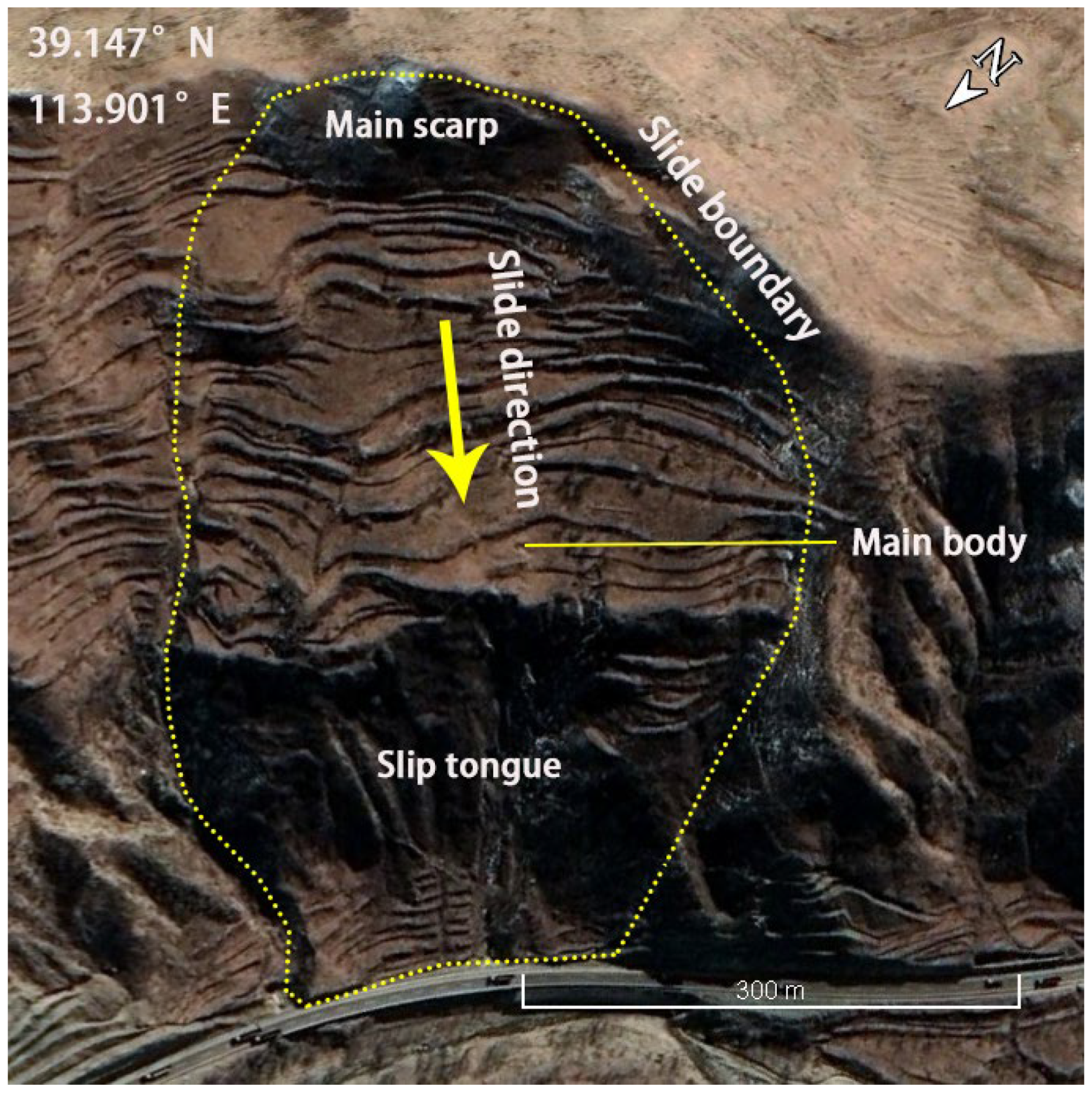
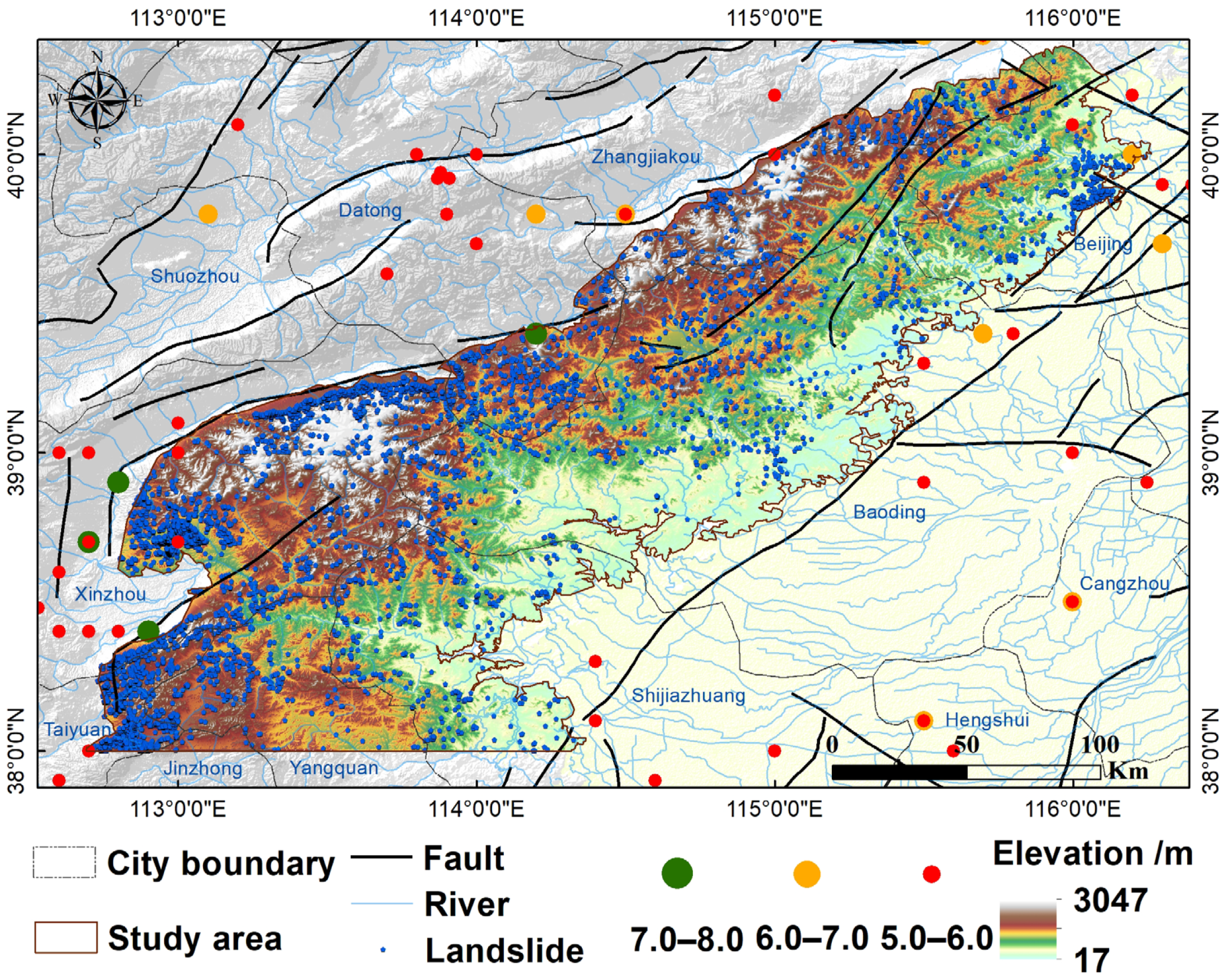
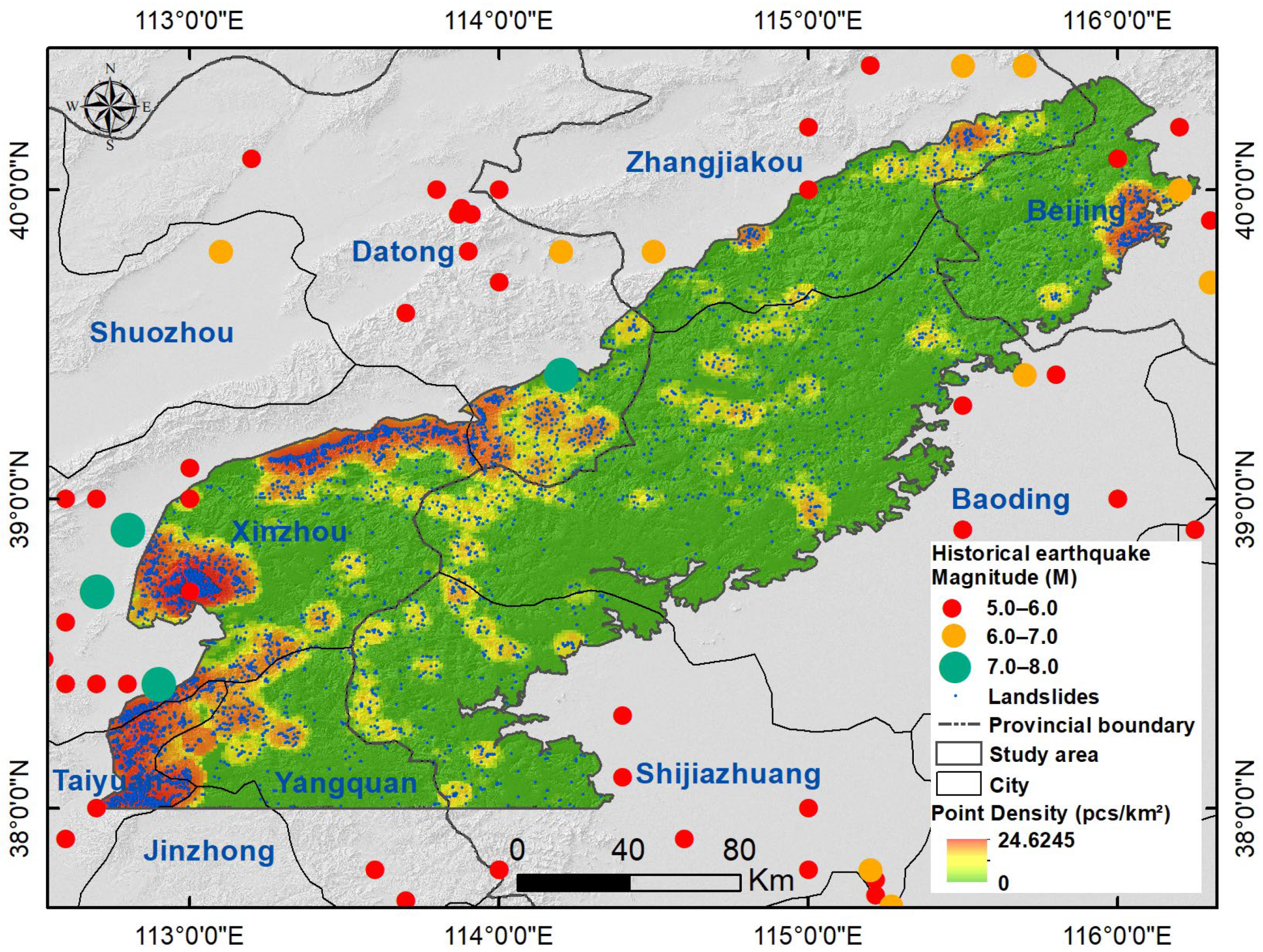
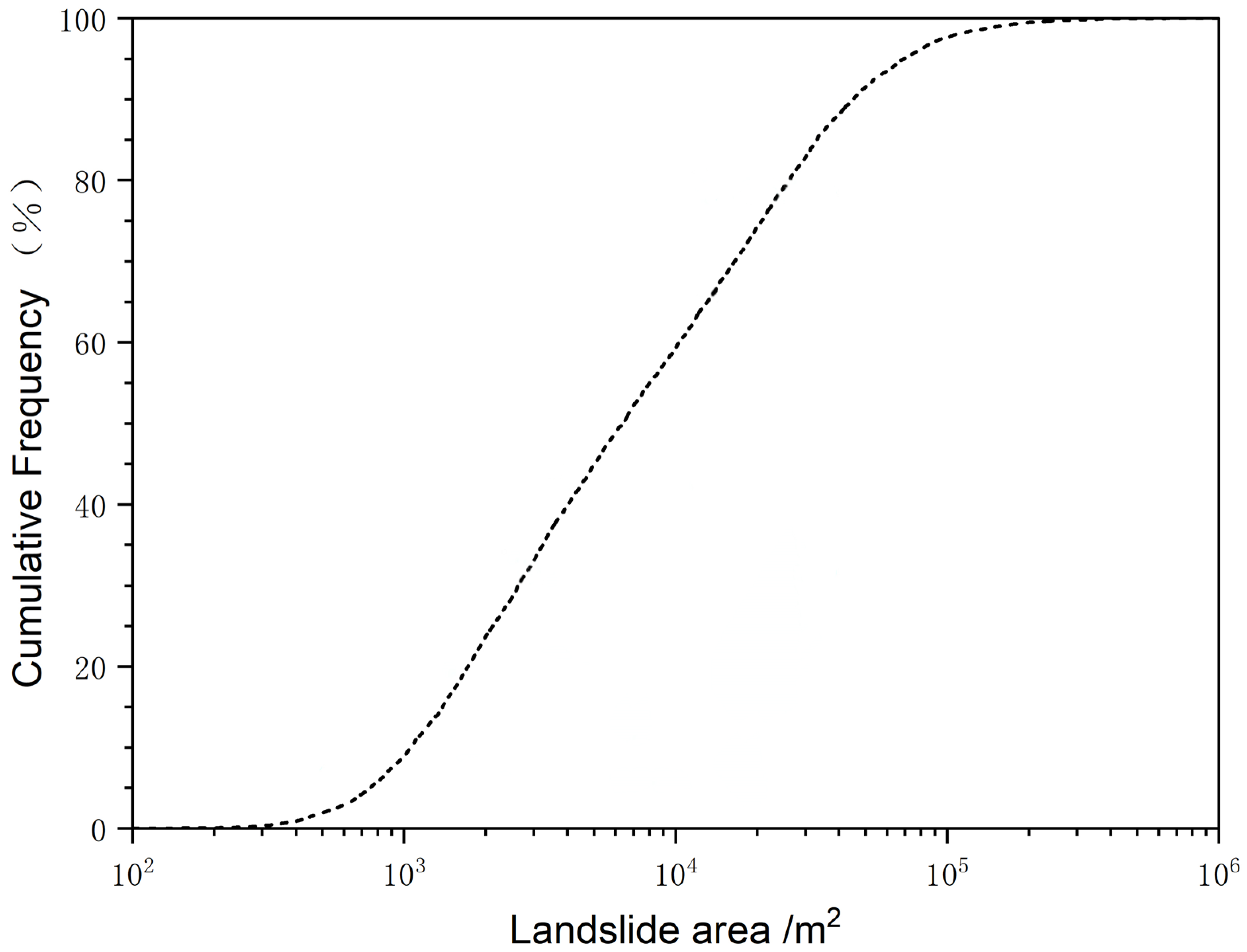
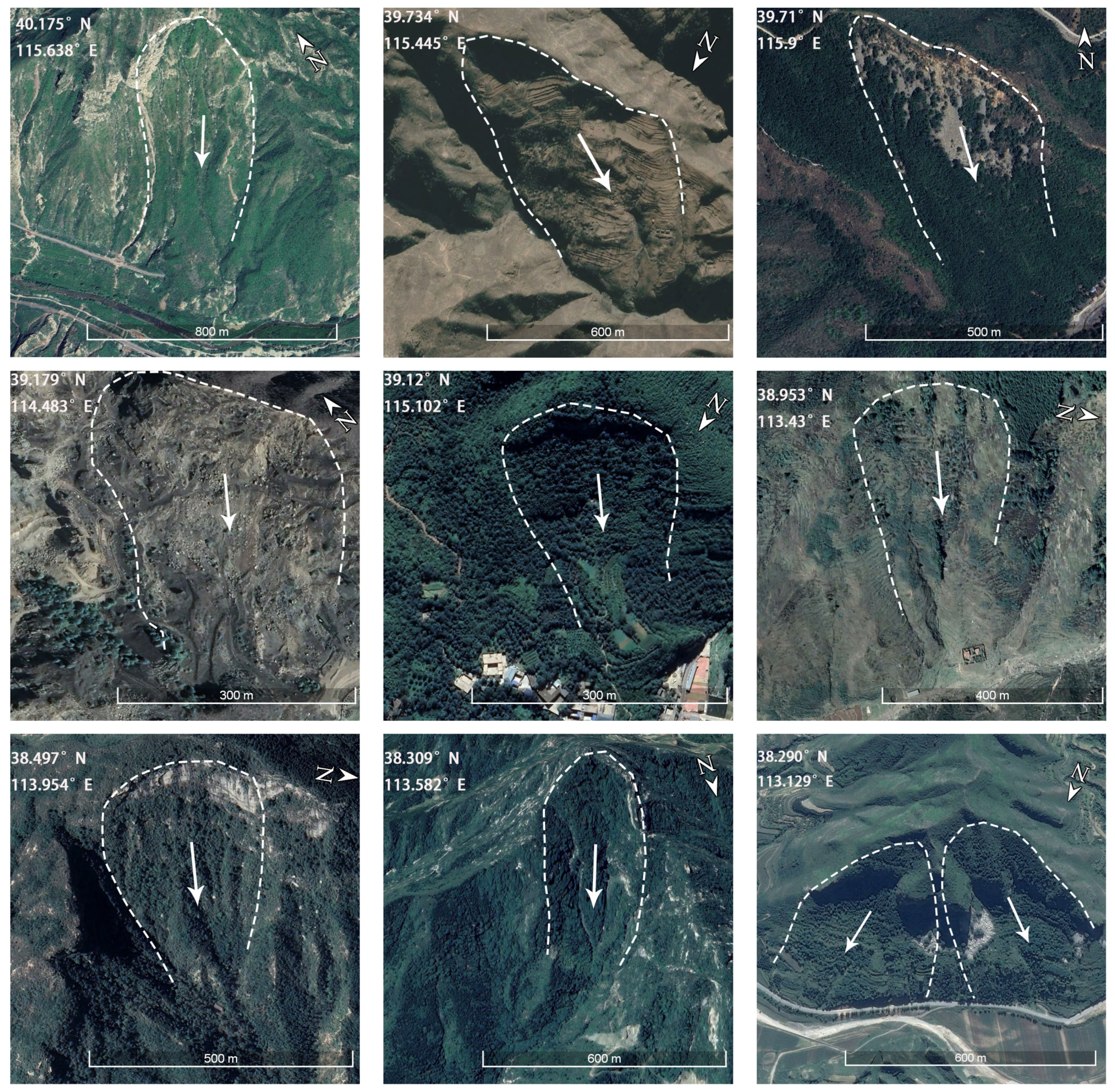
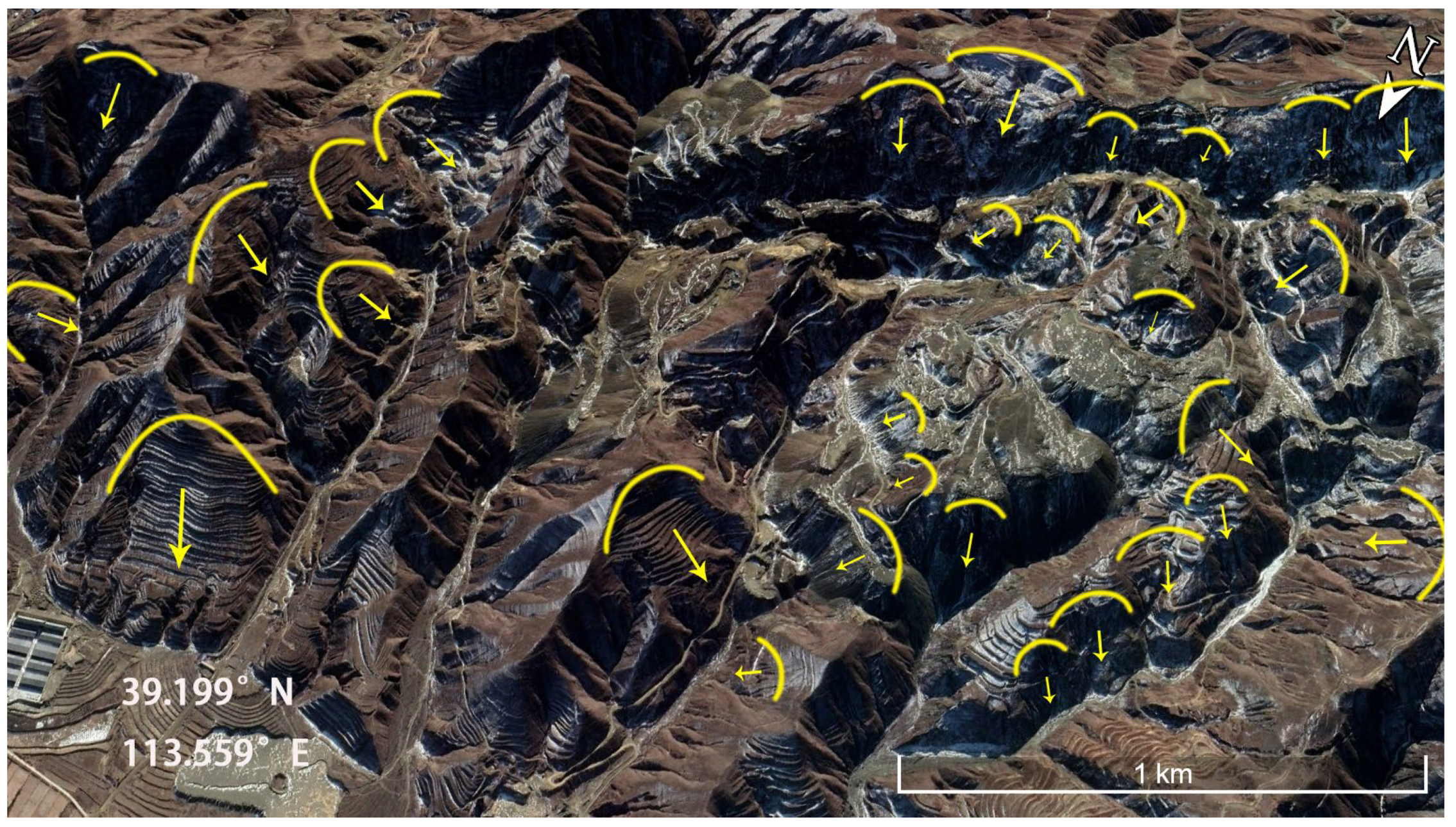

| No. | Location | Landslide Number | Landslide Area (km2) | Source |
|---|---|---|---|---|
| 1 | Qinglong Gorge Scenic Area | 69 | / | [31] |
| 2 | Xiaowutai Mountain National Nature Reserve | 213 | 71.54 | [32] |
| 3 | Sancha village, Fangshan District | 40 | / | [33] |
| 4 | Laiyuan county, Hebei Province | 94 | 2448 | [34] |
| 5 | Xindu district, Hebei Province | 191 | 1941 | [35] |
| 6 | Bailixia, Junma river region | 195 | / | [36] |
| 7 | Taihang Mountain Grand Canyon | 318 | / | [37] |
| 8 | The northern half of the Taihang Mountains region | 8349 | 33,000 | This study |
Disclaimer/Publisher’s Note: The statements, opinions and data contained in all publications are solely those of the individual author(s) and contributor(s) and not of MDPI and/or the editor(s). MDPI and/or the editor(s) disclaim responsibility for any injury to people or property resulting from any ideas, methods, instructions or products referred to in the content. |
© 2024 by the authors. Licensee MDPI, Basel, Switzerland. This article is an open access article distributed under the terms and conditions of the Creative Commons Attribution (CC BY) license (https://creativecommons.org/licenses/by/4.0/).
Share and Cite
Zhang, X.; Xu, C.; Li, L.; Feng, L.; Yang, W. Inventory of Landslides in the Northern Half of the Taihang Mountain Range, China. Geosciences 2024, 14, 74. https://doi.org/10.3390/geosciences14030074
Zhang X, Xu C, Li L, Feng L, Yang W. Inventory of Landslides in the Northern Half of the Taihang Mountain Range, China. Geosciences. 2024; 14(3):74. https://doi.org/10.3390/geosciences14030074
Chicago/Turabian StyleZhang, Xuewei, Chong Xu, Lei Li, Liye Feng, and Wentao Yang. 2024. "Inventory of Landslides in the Northern Half of the Taihang Mountain Range, China" Geosciences 14, no. 3: 74. https://doi.org/10.3390/geosciences14030074






